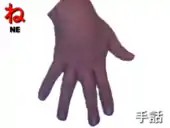Ne (kana)
ね, in hiragana, or ネ in katakana, is one of the Japanese kana, each of which represents one mora. The hiragana is made in two strokes, while the katakana is made in four. Both represent [ne].
| ne | |||
|---|---|---|---|
| |||
| transliteration | ne | ||
| hiragana origin | 祢 | ||
| katakana origin | 祢 | ||
| Man'yōgana | 禰 尼 泥 年 根 宿 | ||
| spelling kana | ねずみのネ (Nezumi no ne) | ||
| unicode | U+306D, U+30CD | ||
| braille | |||
| kana gojūon | ||||||||||||||||||||||||||||||||||||||||||||||||||||||||||||
|---|---|---|---|---|---|---|---|---|---|---|---|---|---|---|---|---|---|---|---|---|---|---|---|---|---|---|---|---|---|---|---|---|---|---|---|---|---|---|---|---|---|---|---|---|---|---|---|---|---|---|---|---|---|---|---|---|---|---|---|---|
|
||||||||||||||||||||||||||||||||||||||||||||||||||||||||||||
| yori · koto · hentaigana | ||||||||||||||||||||||||||||||||||||||||||||||||||||||||||||
As a particle, it is used at the end of a sentence, equivalent to an English, "right?" or "isn't it?" It is also used as slang in Japan to get someone's attention, the English equivalent being "hey" or "hey, you."
| Form | Rōmaji | Hiragana | Katakana |
|---|---|---|---|
| Normal n- (な行 na-gyō) |
ne | ね | ネ |
| nei nee nē |
ねい, ねぃ ねえ, ねぇ ねー |
ネイ, ネィ ネエ, ネェ ネー |
Stroke order
 Stroke order in writing ね |
 Stroke order in writing ネ |

Stroke order in writing ね

Stroke order in writing ネ
Other communicative representations
| Japanese radiotelephony alphabet | Wabun code |
| ねずみのネ Nezumi no "Ne" |
 |
|
 |
 |
| Japanese Navy Signal Flag | Japanese semaphore | Japanese manual syllabary (fingerspelling) | Braille dots-1234 Japanese Braille |
- Full Braille representation
| ね / ネ in Japanese Braille | |
|---|---|
| ね / ネ ne | ねい / ネー nē/nei |
References
| Look up ね or ネ in Wiktionary, the free dictionary. |
| Preview | ね | ネ | ネ | ㋧ | ||||
|---|---|---|---|---|---|---|---|---|
| Unicode name | HIRAGANA LETTER NE | KATAKANA LETTER NE | HALFWIDTH KATAKANA LETTER NE | CIRCLED KATAKANA NE | ||||
| Encodings | decimal | hex | decimal | hex | decimal | hex | decimal | hex |
| Unicode | 12397 | U+306D | 12493 | U+30CD | 65416 | U+FF88 | 13031 | U+32E7 |
| UTF-8 | 227 129 173 | E3 81 AD | 227 131 141 | E3 83 8D | 239 190 136 | EF BE 88 | 227 139 167 | E3 8B A7 |
| Numeric character reference | ね | ね | ネ | ネ | ネ | ネ | ㋧ | ㋧ |
| Shift JIS[1] | 130 203 | 82 CB | 131 108 | 83 6C | 200 | C8 | ||
| EUC-JP[2] | 164 205 | A4 CD | 165 205 | A5 CD | 142 200 | 8E C8 | ||
| GB 18030[3] | 164 205 | A4 CD | 165 205 | A5 CD | 132 49 153 54 | 84 31 99 36 | ||
| EUC-KR[4] / UHC[5] | 170 205 | AA CD | 171 205 | AB CD | ||||
| Big5 (non-ETEN kana)[6] | 198 209 | C6 D1 | 199 101 | C7 65 | ||||
| Big5 (ETEN / HKSCS)[7] | 199 84 | C7 54 | 199 201 | C7 C9 | ||||
- Unicode Consortium (2015-12-02) [1994-03-08]. "Shift-JIS to Unicode".
- Unicode Consortium; IBM. "EUC-JP-2007". International Components for Unicode.
- Standardization Administration of China (SAC) (2005-11-18). GB 18030-2005: Information Technology—Chinese coded character set.
- Unicode Consortium; IBM. "IBM-970". International Components for Unicode.
- Steele, Shawn (2000). "cp949 to Unicode table". Microsoft / Unicode Consortium.
- Unicode Consortium (2015-12-02) [1994-02-11]. "BIG5 to Unicode table (complete)".
- van Kesteren, Anne. "big5". Encoding Standard. WHATWG.
This article is issued from Wikipedia. The text is licensed under Creative Commons - Attribution - Sharealike. Additional terms may apply for the media files.


